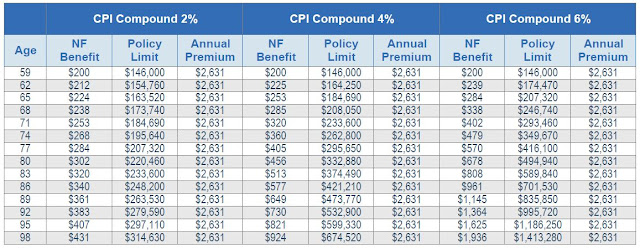Of the People who reached age 65: Men 1 out of 3, Women 1 out of 2 will need a Nursing Home before death. The average stay will be 2.5 to 3 years. For everyone who needs a Nursing Home 4 will be taken care of at home.
I have said it so many times it has lost it's meaning. So hear are some new stats that I hope will bring back into focus the growing long-term care need.
According to the U.S. Department of Health and Human Services, in 2007, about nine million men and women over the age of 65 will need long-term care services. By 2020, 12 million older Americans will need long-term care. Most will be cared for at home. In fact, an agency study revealed that family and friends are the sole caregivers for 70 percent of all elderly Americans needing long-term care. The research also showed that people who reach age 65 have a 40 percent chance of entering a nursing home during their lifetime. About 10 percent of the people who enter a nursing home will stay for five years or more.
A research project concerning the likelihood of needing long-term care services was conducted by Milliman USA, (an actuarial consulting firm). The results of the study were published in the December 2005 edition of LTCi Sales Strategies magazine:
Out of every 1,000 65-year-old policyholders:
- 449 will need LTC services
- 106 will need LTC for > 2 years
- 59 will need LTC for > 3 years
- 34 will need LTC for > 4 years
- 20 will need LTC for > 5 years
- 106 will need LTC for > 2 years
- 59 will need LTC for > 3 years
- 34 will need LTC for > 4 years
- 20 will need LTC for > 5 years
The length of stay also varies significantly depending on the policyholder’s gender and whether the policyholder is married or single. The two “extremes” for a 65-year old are shown (that for a married male (lowest) and a single female (highest)):
Out of every 1,000 married 65-year-old males:
- 302 will need LTC services
- 20 will need LTC for > 2 years
- 12 will need LTC for > 3 years
- 7 will need LTC for > 4 years
- 4 will need LTC for > 5 years
- 20 will need LTC for > 2 years
- 12 will need LTC for > 3 years
- 7 will need LTC for > 4 years
- 4 will need LTC for > 5 years
Out of every 1,000 single 65-year-old females:
- 555 will need LTC services
- 70 will need LTC for > 2 years
- 51 will need LTC for > 3 years
- 35 will need LTC for > 4 years
- 23 will need LTC for > 5 years
- 70 will need LTC for > 2 years
- 51 will need LTC for > 3 years
- 35 will need LTC for > 4 years
- 23 will need LTC for > 5 years
Joe Friday on Dragnet always said "Just the facts mam."
These are the facts. So what? Facts mean little unless accompanied with "Personal Experience". Again emotion triumphs logic. Facts don't motivate-real life experiences do.
These are the facts. So what? Facts mean little unless accompanied with "Personal Experience". Again emotion triumphs logic. Facts don't motivate-real life experiences do.
It is Life that occurs while weighing the facts.

























